County Closes Lake Park Bridge
Abele administration cites safety concerns, seeks $2 million in private funds.
The Ravine Road Bridge in Milwaukee’s Lake Park is now locked up behind chain-link fencing—with plenty of drama swirling around it. The historic landmark was closed off December 9–possibly for years–“because the County cannot control the volume on the bridge,” according to a statement from Milwaukee County Executive Chris Abele’s office. County officials said, “While there is no immediate safety concern for normal day-to-day use… the County’s Engineering and Risk Management Departments made the recommendation to err on the side of caution and close the bridge as we lack operational control over large groups that could potentially overload the bridge.”
Those groups, however, would have to be fairly large. Teig Whaley-Smith, county director of administrative services, told the county board’s finance committee last week that the bridge was safe for “normal use”, but a huge crowd would be problematic. He defined a potentially unsafe gathering as “10 people per 10 square feet across the entire bridge.” That would total at least 1,180 people, since the bridge measures 118 feet by 10 feet. More recently, he clarified this statement to the board, to say that the engineer’s calculations show the bridge could hold up to 181 people. (See update below.)
But the county has not permitted special events on or across the bridge in the past 18 months, says Melissa Baldauff, Abele’s director of communications. So why the closure has come at this point is not clear. Baldauff says the decision was not based on changes in the bridge’s condition or Pokemon players in the park.
After safety concerns about the bridge were raised two years ago, Ravine Road beneath it was closed to vehicular traffic in December 2014. Additional barriers were installed last week at both ends of Ravine Road.
Temporarily closed in 2014, the deck reopened after thorough study, except for service vehicles. Monitoring of the bridge has been ongoing, says Baldauff.
Definitions of Safety
The decision to spend $7,000 for fencing was based on “a report prepared by the independent engineering consultants at GRAEF in July of 2015,” says Baldauff. She cites “confirmed assessments dating back to 1905 that the bridge cannot handle more than 30 psf [30 pounds of pressure per square foot].” However, county and Graef officials have repeatedly attested that the bridge is structurally sound, including the supporting arch.
Nonetheless, Sup. Sheldon Wasserman, who represents Lake Park’s neighborhood, expressed safety concerns: he cites GRAEF’s statement that the bridge “had run its life cycle and replacement should be considered.” However, Karl Stave, the county’s project director for the bridge, clarified that the report said the bridge “should either be rehabilitated or replaced” and that the county has been considering several options.
Bert Hartman, a bridge engineer with Oregon’s Department of Transportation, recognized nationally for its bridge program, says that closing a bridge “does not mean it is inherently unsafe or poses any imminent danger.” He adds that his department often “strengthens such bridges and reopens them.”
Bridge Could Be Demolished?
Wasserman says that if it appears park users are bypassing the fencing, he believes “the County will issue an immediate emergency demolition order.” He adds “if lives are at stake because of a bridge collapse, I would support an emergency order.”
County officials have repeatedly touted immediate demolition of the bridge. Last week Whaley-Smith pitched a “two-step process” to supervisors: First, tear down the bridge and then work on replacing it. At a public-information meeting in July, county landscape architect Kevin Haley proposed the same demolish-first/plan-later “compromise.” Outright demolition—without replacement–had already been presented as the “lowest-cost option.” Many neighbors and supporters of Lake Park have opposed both approaches while supporting rehabilitation or replacement with a reconstructed “replica.”
Some suspect the situation is being calculated to trigger a raze order, which the Abele administration denies. When asked if demolition is pending, Baldauff says, “At this point, the administration is prepared to move forward with [replacing the bridge] once the $2,000,000 is raised by the friends groups.”
Private Donations Sought
The Abele administration has projected a budget where $2 million of the bridge’s $2.5 million cost comes from private donors. According to his office: “The bridge will be closed to all traffic until a replacement or repair alternative is finalized… This project shall not proceed until the $2,000,000 in private contributions is secured and committed.”
But where that money will come from is far from clear. As Urban Milwaukee previously reported, an anonymous donor had pledged a $1 million contribution with the proviso that Ravine Rd. be permanently closed to auto traffic, but the donor has reportedly withdrawn the offer.
Asked whether administration officials have communicated with park neighbors and friends about the expectation to raise $2 million, Baldauff responded, “Not at this time.” She added, “We’ve heard that several individuals and groups may have an interest in contributing to the repair of the bridge, but haven’t received any specific offers or donations.” She adds that a “Memorandum of Understanding is being drafted to be circulated to friends groups who may have an interest in raising the additional funds.”
But the board of Lake Park Friends (LPF) has stated they would be unable to play such a role. No “stakeholder” group has raised anywhere near $2 million in private donations for other projects. Representatives of LPF and Historic Water Tower Neighborhood, who sat on a committee studying the bridge’s future, told county officials months ago they would not be able to raise private funding to restore or replace the structure.
Asked whether the administration caged off the bridge to put pressure on neighbors to come up with such funding, Baldauff responds, “No, and frankly that question is offensive.” She reiterates, “We are closing the bridge out of an abundance of caution to ensure the safety of the public and Parks workers.”
Lake Park Friends president Alice Wilson says the group’s members “fully understand the fiscal challenges the county is facing.” She notes, however, that “we are looking for a comprehensive plan from the county about what it plans to do about the bridge, with actionable solutions.” She said the Friends will “continue to advocate for this historic treasure and encourage its enjoyment by everyone.”
Other Potential Governmental Funding
Park neighbor Julia Taylor (who runs the Greater Milwaukee Committee but notes she is speaking as a private citizen) says in an email that “as an area resident, I am very disappointed that access to the Ravine Bridge was suddenly closed without public input. My understanding is there are no significant structural changes since the July 2015 engineering report, so this seems a draconian move.”
She adds that “we need to address the bigger issue of tax policy and shared revenues for Milwaukee as a community. I hope there will be a chance for public discussion on the closing of the bridge and re-evaluation of this decision. This issue is just one of many structural issues for our public parks and facilities throughout the county. If we decided to close every public structure in the county that is at the end of its “structural life.” there would be few public spaces not touched.”
This bridge project is likely eligible for federal funding through a Transportation Alternatives Program grant for up to 80 percent of costs. County officials have repeatedly played down that fact. January 2018 is the next application deadline.
Tim Sheehy, president of the Metropolitan Milwaukee Association of Commerce, recently said his group and other civic leaders have begun meetings to discuss options for a sales tax to fund county parks and cultural institutions.
Severing the Park’s Connectivity
With the bridge closed, pedestrians and bikers must make considerable detours, generally to the park’s western perimeter. Another wooden footbridge near the Warming House and Locust Street Ravine is also closed. Says Taylor: “This lack of public access is creating a park suddenly cut in two for those of us who are in the park daily.”
Wilson notes the park “attracts people from all over the county, state and beyond and brings more joy to people of all backgrounds than we can quantify.” It’s a destination for picnics, field sports, golf, hiking through rustic ravines, lawn bowling, birdwatching and summer concerts. The mile-long, linear path along the park’s eastern perimeter, which includes this historic bridge, is a popular among strollers, runners and bicyclists.
Built in 1906, the bridge is next to the Pavilion and Grand Staircase. All three were designed by Alfred C. Clas and George Bowman Ferry. Frederick Law Olmsted orchestrated the park’s master plan.
The county board’s finance committee rejected, 6-0, a proposed GRAEF contract for $139,664 to design a replacement bridge. GRAEF has already received $98,812 to study potential bridge options, in addition to engineering contracts for the existing bridge.
The finance committee discussed the fact that $2 million must be raised privately before a bridge project could proceed. Board members wondered whether it was appropriate, in the interim, to spend more taxpayer dollars on planning. Instead, at Wasserman’s suggestion, the committee voted to transfer $100,800 to the Ravine Road project from funds allocated in the 2017 budget for GRAEF to study options for another bridge in Lake Park.
The fate of the bridge is likely to get discussed by county board members soon. Says Sup. Jason Haas: “I will definitely have this on the agenda at the next Parks Committee meeting.”
UPDATE 2 p.m. December 19: In response to this story, Teig Whaley-Smith issued the following memo to the County Board:
“It was reported that the number of people that the Lake Park Ravine Bridge could support “would total at least 1,180 people, since the bridge measures 118 feet by 10 feet.” I wanted to let you know that for the reasons stated below, the number is 181 people, not 1,180.
This article was based on a comment at the Finance Committee that a visual representation would show that 30 pounds per square feet is approximately 10 people in a 10 foot by 10 foot area. A 10 by 10 foot area is 100 square feet but I may have misstated as 10 square feet at the committee. I apologize for any confusion. Again, this comment was just an estimate not an exact number.
After consulting with our engineers, the correct calculation would be as follows. The bridge is approximately 118 feet long and 10 feet wide for a total of 1,180 square feet. The bridge can support 30 pounds per square foot. 1,180 Square feet times 30 pounds per square foot is 35,400 pounds. This weight could only be supported if the weight was evenly distributed across the bridge. The average American male adult is 195.5 pounds. 35,400 pounds divided by 195.5 pounds per adult equals 181 adults.”
The Ravine Road Bridge (Lake Park Arch Bridge)
More about the Ravine Road Bridge Project
- City Should Enforce Reopening of Ravine Road, Park Friends Say in Filing - Lake Park Friends - Sep 28th, 2023
- MKE County: Ravine Road Debate Heats Up - Graham Kilmer - Aug 14th, 2023
- MKE County: Ravine Road Project Could Begin in 2024, With Pedestrian-Only Option - Graham Kilmer - Aug 1st, 2023
- MKE County: Lake Park Bridge Open For First Time In 6 Years - Graham Kilmer - Oct 29th, 2022
- Friday Photos: Lake Park Bridge Overhaul Nears Completion - Jeramey Jannene - Sep 23rd, 2022
- MKE County: Lake Park Bridge Needs $1 Million More - Graham Kilmer - May 18th, 2021
- County Receives $2 Million Grant for Lake Park Bridge - County Executive Chris Abele - Sep 12th, 2018
- County Parks To Seek State Grant to Fund Ravine Road Bridge Project - Milwaukee County Parks - Feb 8th, 2018
- Op-Ed: Lake Park’s Bridge Spans History - Paul Daniel Marriott - Apr 5th, 2017
- Public Forum For Lake Park Bridge - Virginia Small - Feb 13th, 2017
Read more about Ravine Road Bridge Project here



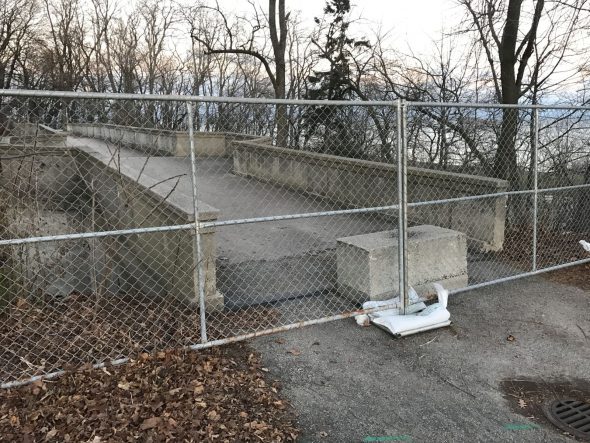
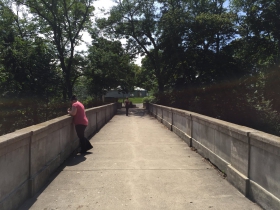
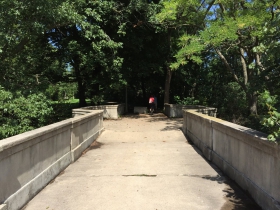
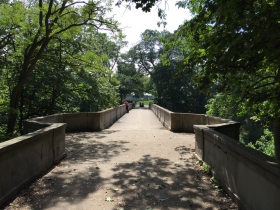
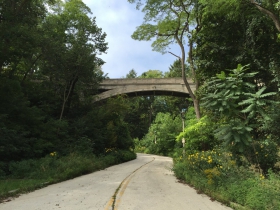
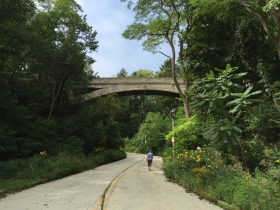
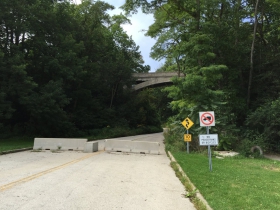















Absurdities abound. This bridge can handle the foot traffic. And the chain link barrier is SO Tacky. À Plutocratic effrontery.
This is the link to the July 2015 Graef report on the bridge reffed in the article:
http://county.milwaukee.gov/ImageLibrary/Groups/cntyParks/Planning/LakeParkoverRavineRoadInDepthReportFinal2015-07-23.pdf
Here’s Milwaukee County Parks’ “Historic Resources Managemen Plan,” released n 2013:
http://www.thc.texas.gov/public/upload/preserve/survey/highway/Milw%20Co%20Historic%20Properties%20Management%20Plan.pdf
A dreadful choice for blocking vehicular traffic. How about planters to hold our beautiful Wisconsin evergreens. Thus stopping “forbidden” traffic but allowing pedestrians to enjoy our world class park.
Birdseye view of original 1895 bridge plans (sans roadway & park extension) found here:
https://www.facebook.com/photo.php?fbid=839868022821771&set=o.190247763021&type=3
The total cost of construction for both bridges was $60K (from the Milwaukee Herold).
Very disappointing decision for those who use the bridge regularly particularly since the report states that the bridge can support pedestrian traffic.
Another sad state of affair, two years down and best the system can achieve is a fence , pathetic.
On the other hand, every time i visit this website my computer hangs up costing me time. that sucks,
I am unsubscribing, don’t call back
The author is right to question if the bridge could be demolished, but it is even more draconian. With emergency order, the county ordinances allow unilateral action by the county executive. This means that crews could be sent in the wee hours of the morning by unilateral action of one person without any checks or balances. There is a real issue as to whether this is proper declaration here and whether this is an emergency. It would be a great tragedy for our Park system and the Olsmstead legacy to have such a structure declared unsafe and unilateral orders given to destroy this legacy. I think it would be a very unwise move by the executive which would result in an outcry of “foul” by citizens. Money is not the problem, it is the selection of our priorities and who gets to say where the money will be spent. Need I say the words, “new arena?”
@Gary That image depicts the Lion bridges that are north of the bridge in question. If those were closed down I’m sure the money would be raised very quickly.
Looks like they will most likely use an exaggerated safety concern to speed up the razing of the bridge. Have they cordoned off the area directly under the bridge as well?
My opinion on the matter is tear it down and put up a modern bridge that has some aesthetic. Being able to experience the park is more important than struggling with the preservation of this particular bridge.
@Gary That image depicts the Lion bridges that are south of the bridge in question. If those were closed down I’m sure the money would be raised very quickly.
Looks like they will most likely use an exaggerated safety concern to speed up the razing of the bridge. Have they cordoned off the area directly under the bridge as well?
My opinion on the matter is tear it down and put up a modern bridge that has some aesthetic. Being able to experience the park is more important than struggling with the preservation of this particular bridge.
@Jackson, in response to your question about the area directly under the bridge: Yes, tall chain-link fencing and cyclone fencing was also installed at both ends of the road last week to restrict all access, not just vehicles.
Concerns about the bridge’s underside relate to flaking concrete, similar to spalling concrete within the Domes. The county is considering installing wire mesh to prevent any such flakes from falling. Engineers have always confirmed that the bridge’s arch is completely sound, with a “90 psf rating,” the standard for arches of pedestrian bridges. So there has been no stated concern about the arch possibly collapsing.
In a December 9 memo to County Board members, Teig Whaley-Smith, director of administrative services, outlined what the county is considering:
“4. Next Steps Immediate need
Not knowing how long it will take the friends groups to raise the requisite funds, the County still needs to take immediate action to make sure the area is safe and secure. The temporary barricades are not a sufficient solution. The County is preparing estimates for two immediate alternatives. One is steel mesh, similar to the Domes that would hold material from falling to the drive below. This would allow the drive to reopen, but not the bridge itself. The second immediate alternative is to complete step 1 of the Replace-in-Kind strategy which is to demolish the bridge. This second option would also allow the drive to be opened.
The immediate decision point by the Board is around the temporary closure. The primary decision that needs to be decided by the Board is whether to (a) keep the fencing in place until funds are raised with an unknown duration, (b) mesh wiring that would open the drive but not the bridge until funds are raised with an unknown duration, or (c) complete step 1 of the Repair and Replace alternative, in which case the drive would be open, and the bridge rebuilt when funds are raised. If you need any further information to inform your decision making process, please do not hesitate to contact me.”
It should be noted that all those supporting a “replace-in-kind” solution put in writing a proviso: They firmly oppose any demolition of the bridge until all funding for a new bridge is in hand and a plan for such a replacement is fully approved.
Whats all this I hear about volume on the bridge these kids should play the radios at home.
Thankyou.
Metaphors about bridges are legion. This (mis)calculated brinksmanship is “a bridge too far.” Smart civic leaders know their value and maintain historic/landmark bridges–they don’t scheme to (in effect) “burn” them.
It’s simply not believable that county officials fear that hundreds of East Side gentry or Pokemon rabble will suddenly descend upon this bridge–for any reason–without the requisite event permit. Ravine Road Bridge is tucked away in the woods, which is one reason Chris Abele thinks he can get away with tearing it down.
Just post a maximum bridge-occupancy and trust the good citizens of Milwaukee County to obey regulations. Don’t insult their common sense. In 50 years, I’ve never seen more than a dozen people on this bridge at any time–much less hundreds.
Mr. Abele, please stop making Frederick Law Olmsted spin in his grave. Using this bridge as a pawn in one of your silly little games is just wrong.
I’m very glad the anonymous donor removed his idiotic plan too close Ravine Road to vehicular traffic. It boggles my mind why someone who supposedly lives in the neighborhood would want to do that. Does he really enjoy having me and everyone else traveling there drive through his neighborhood every time I visit the park?
There is a large parking lot to the east of Lake Park, accessed right where Ravine Road used to meet Lincoln Memorial Drive. There is a parking lot on the north of the park, accessed off LMR, there is parking along the entire western edge of the park and if you enter from Newberry, there are parking areas both north & south.
I’d wager that Lake Park has enough parking options and ways to get there. Have you walked through Ravine Road without traffic? It’s beautiful in every season and is an experience that wouldn’t exist with the traffic allowed back.
Re: Ravine Road: One approach that Milwaukee could consider would be to establish a formal process for reviewing proposed changes to Milwaukee’s Olmsted parks. Friends of Seattle Olmsted Parks (FSOP) does this. (FL Olmsted’s son John Charles designed that system which has many remarkable parks; he was renowned in his own right.) From their website:
“FSOP also works closely with the Seattle Department of Parks and Recreation and other public agencies to provide independent review of projects in Seattle’s Olmsted Brothers-influenced parks and boulevards. FSOP helps ensure that proposed changes preserve or enhance the role the park or boulevard in the park and boulevard system John Charles Olmsted planned for the City of Seattle between 1903 and 1912 and that they are consistent with the designs developed by the Olmsted Brothers Landscape Architects firm for the individual landscapes.
The FSOP board is composed of citizens with expertise in landscape architecture, history, horticulture, arboriculture, business management, and urban planning. A number of our board members are involved in the preservation and revitalization of individual Olmsted-influenced landscapes in addition to their participation in FSOP’s work.”
http://seattleolmsted.org/about
Some other cities with Olmsted parks also have review procedures. It affords changes that are well-considered that preserve and enhance the legacy parks and their neighborhoods.
I am very angry regarding the lack of action on the bridge, why is the County holding residents hostage. This is a County facility! The County has failed to appropriate replacement costs, it is going on three years, my goodness. I believe that the County’s position of closing the Bridge until $2 mm is raised is ridiculous. I already paid for swing recreation area that the County ripped down and replaced.
This is pathetic, near by residents already pay significant taxes, why would the entire county pay the cost?